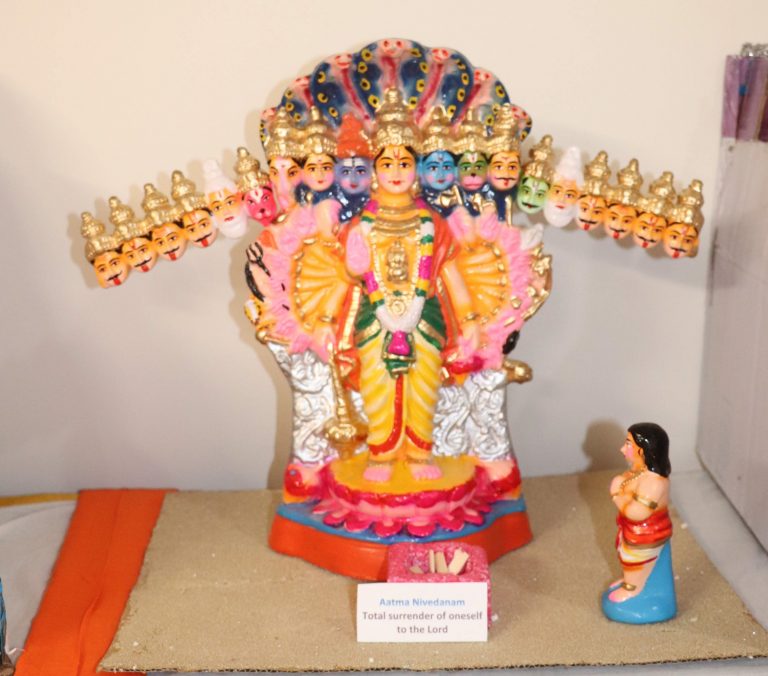Nine Devotions
Nava Vida Bhakthi
‘Nava’ means nine, and ‘Vidha’ means approach and “Bhakthi” means devotion , Nava Vidha Bhakthi stands for nine forms of devotion that one can follow to reach the god. I
Srimad Bhagavatham elaborates nine forms of bhakti which, if cultivated and practiced regularly will no doubt lead us closer to the lord: shravanam, kirtanam, vishnoh smaranam, paada-sevanam, archanam, vandanam, daasyam, sakhyam, aatma-nivedanam (Srimad Bhagavatham 7.5.23).
The nine forms of devotion are:
- Shravanam – Hearing the names and glories of the Lord
- Keertanam – Chanting His glories
- Smaranam – Remembering the Lord
- Paada sevanam – Serving the Lord’s feet
- Archanam – Worshiping the Lord
- Vandanam – Offering obeisance unto the Lord
- Daasyam – Serving the Lord as His servant
- Sakhyam – Developing friendship with the Lord
- Aatma Nivedanam – Total surrender of oneself to the Lord
We have depicted stories and characters from Hindu Mythology to explain the concept of Nava Vida Bhakthi
Shravanam -Hearing the names and glories of the Lord
Story of Kakabhushundi and Garuda
Kakabhushundi is an ardent devotee of Lord Rama and was the first to narrate the Ramayana to any creature in the world. He is an Immortal and it is said that the place he resides at, stays safe from the effects of Kaliyuga. KakaBhushundi is blessed by Lord Shiva with intact memory of past life devotion .
Kakabhushundi was born as a brahmin ,and due to some arguments was cursed by his guru sage Lomash to be born as a crow. The Sage realized the adversity of anger and blessed him with ability to travel through time . Kakabhushundi flew to Badrinath and lived there when the Kaliyuga of a Kalpa was over and a fresh aeon arises. Being blessed to travel through time KakaBhushundi was able to survive that apocalypse
In the beginning of new Aeon, Lord Shiva was narrating the story of Lord Rama to Devi Parvati. Kakbhushundi, who was present there , heard the story and became more devoted to Rama and was blessed to attain liberation through his devotion to Rama . Because of his blessing from Lord Shiva to stay out of time and watch Aeons as they pass by , Kakbhushundi was able to see Ramayana play out 11 times and Mahabharatha 16 times. The Rmayana that Lord Shiva told Devi Parvati and Kakabhshundiis called Adhyatma Ramayana
Once in Tretayuga , Lord Rama and Lakshmana were hypnotized by a Naagapasha thrown by Meghanad , Son of Ravana. Garuda (the Eagle vehicle of Lord Vishnu) arrived there to dismantle the effects of the Naagapasha.
After the work was done , Garuda was curious why Lord Rama did not save himself from the Naagapasha , though he is the avatar of Lord Vishnu. Upon the advise of Sage Narada , Garuda (the eagle and the king of all birds) goes to Kakabhushundi( a crow and lowest in the strature in the bird family) and requests him to educate him on Ramayana
This story shows the importance of reaching god through hearing his stories.
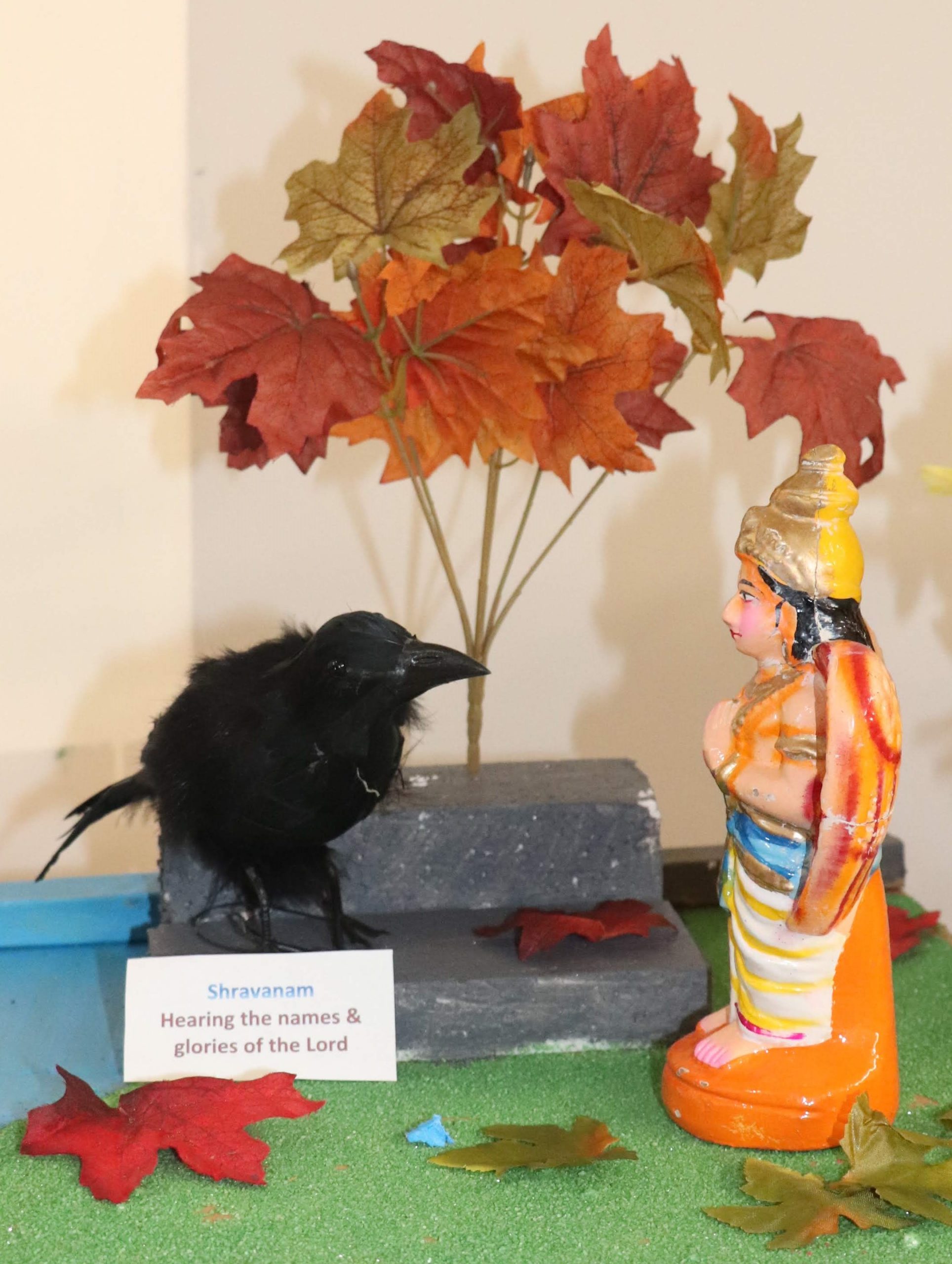
Keertanam – Chanting His glories
Story of Tumburu
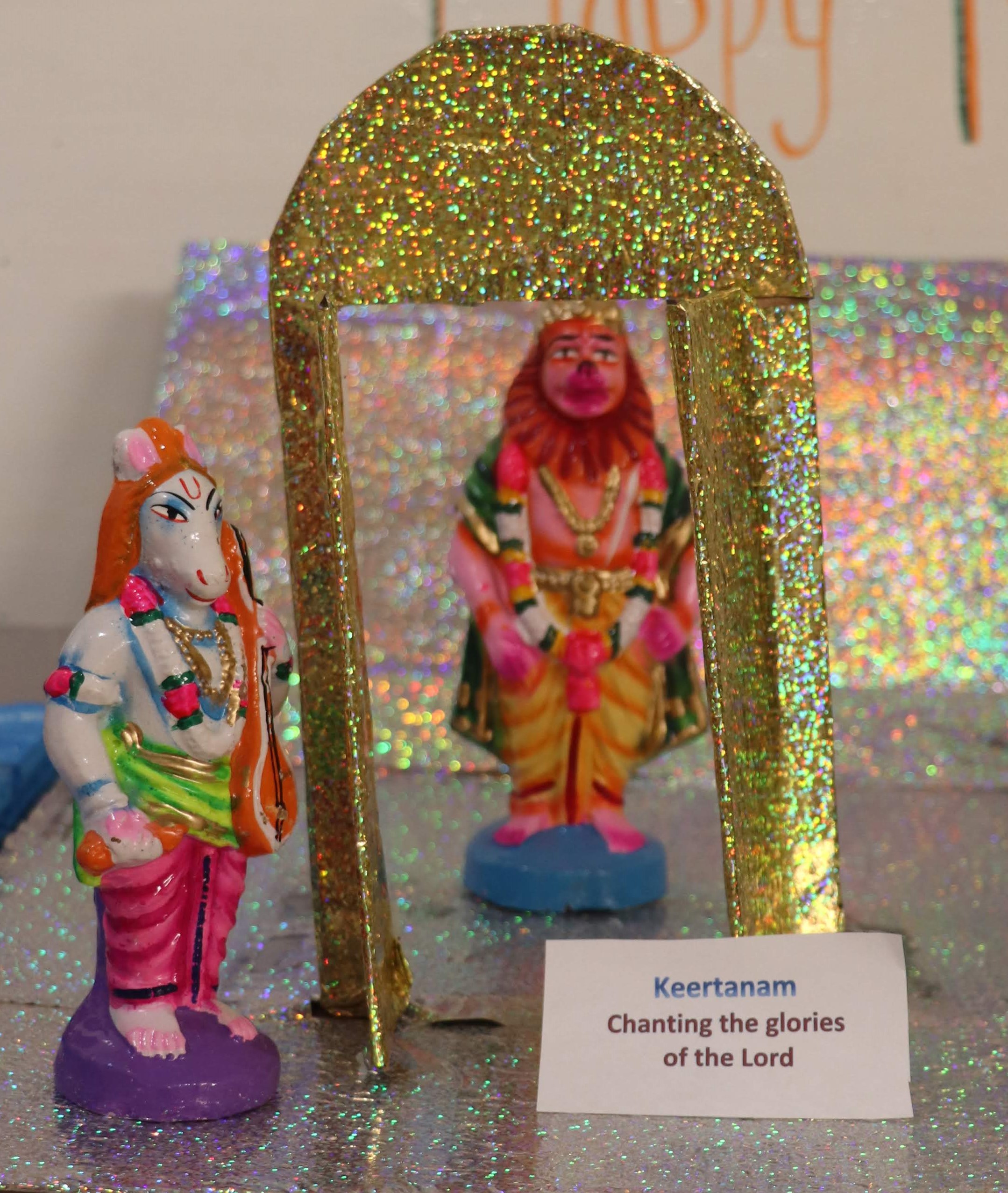
Smaranam – Remembering the Lord
Story of Narada
Narada was a god-sage considered a saktyavesa-avatar or partial-manifestation (avatar) of God, empowered to perform miraculous tasks on Vishnu’s behalf. Bhagavatha Purana details him as the primary source of information among Gods.He is believed to be the first journalist on Earth. In his previous birth, Narada was a gandharva who had been cursed to be born on an earthly planet for singing glories to the demigods instead of the Supreme Lord. He was born as the son of a maid-servant of some particularly saints. The saints, being pleased with both his and his mother’s service, blessed him by allowing him to eat some of the prasad, food previously offered to their lord, Vishnu.
Gradually he received further blessings from these sages and heard them discussing many spiritual topics. During the four months of rainy seasons when the sages did not leave their hermits and stayed together, they used to recite various deeds of Vishnu, and from there Narada used to hear these stories. After his mother died, he decided to roam the forest in search of enlightenment in understanding the ‘Supreme Absolute Truth’.
Narada sat under a tree in meditation and began concentrating on Vishnu within his heart as he had been taught by the saints he had served. After some time Narada experienced a vision wherein Vishnu appeared before him, smiling, and spoke: “that despite having the blessing of seeing Him at that very moment, Narada would not be able to see His (Vishnu’s) divine form again until he died”. Vishnu further explained that the reason he had been given a chance to see his form was that his beauty and love would be a source of inspiration and would fuel his dormant desire to be with the lord again. After instructing Narada in this manner, Vishnu then disappeared from his sight. The boy awoke from his meditation both thrilled and disappointed.
For the rest of his life, Narada focused on his devotion, meditation upon and worship to Vishnu.
Narada is known for chanting “Narayana Narayana” all through his life and thus remembering the god through chanting the name of god
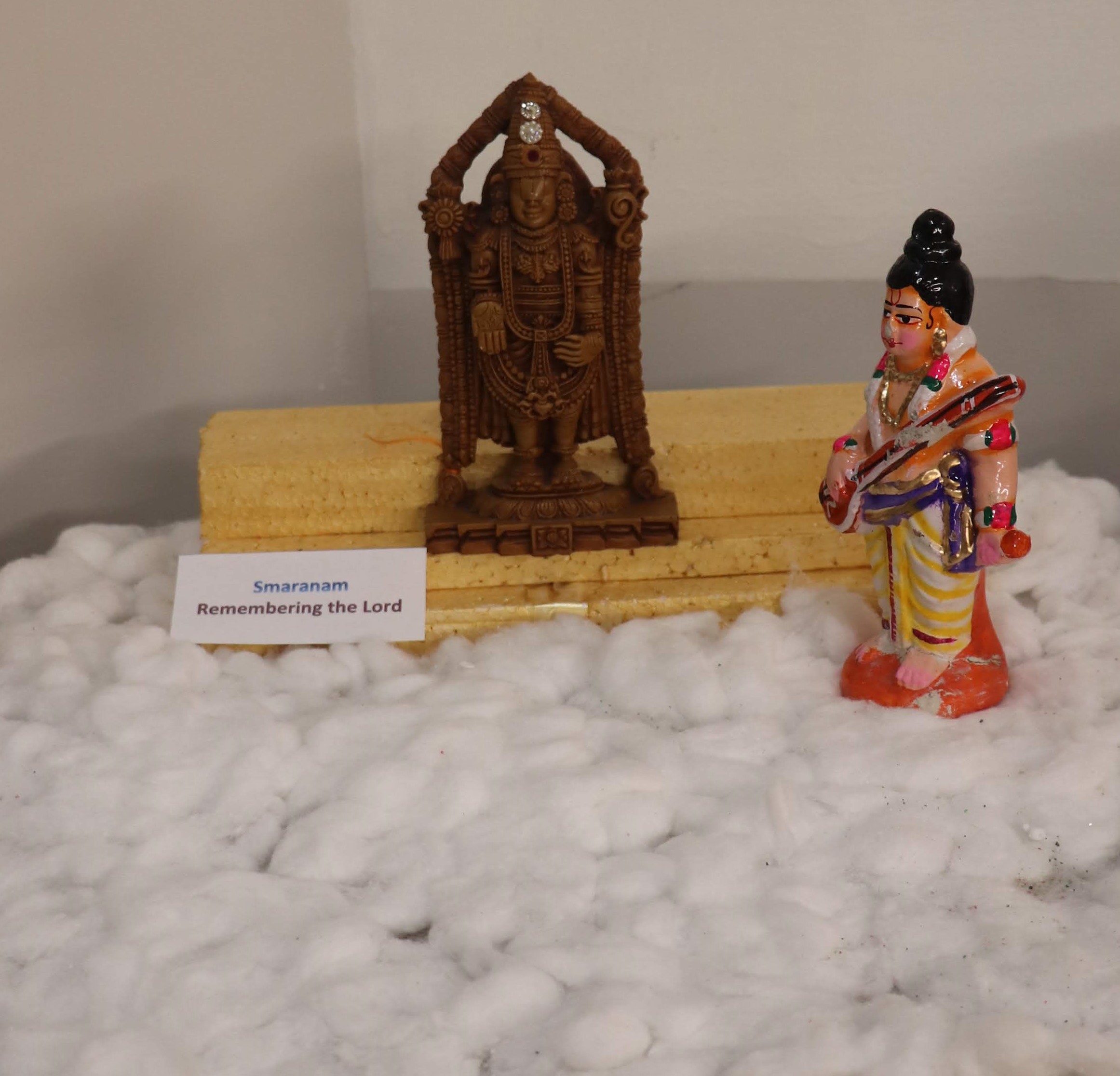
Paada sevanam – Serving the Lord’s feet
Story of Lakshmi
Goddess Lakshmi is the goddess of wealth, fortune and prosperity. She is the “eternal” consort and shakti (energy) of God Vishnu. The image of Goddess Lakshmi Vishnu’s feet should be perceived to understand the devotional aspect of life.
In Srimad Bhagavatham 10.14.58; Lord Brahma says
” For those who have accepted the boat of the lotus feet of the Lord, who is the shelter of the cosmic manifestation and is famous as Murāri, the enemy of the Mura demon, the ocean of the material world is like the water contained in a calf’s hoof-print. Their goal is paraṁ padam, Vaikuṇṭha, the place where there are no material miseries, not the place where there is danger at every step.”
Though Goddess Lakshmi is the Goddess of wealth and presides over all forms of prosperity, the goddess shows to the world that serving the Supreme is greater than all the treasures on earth
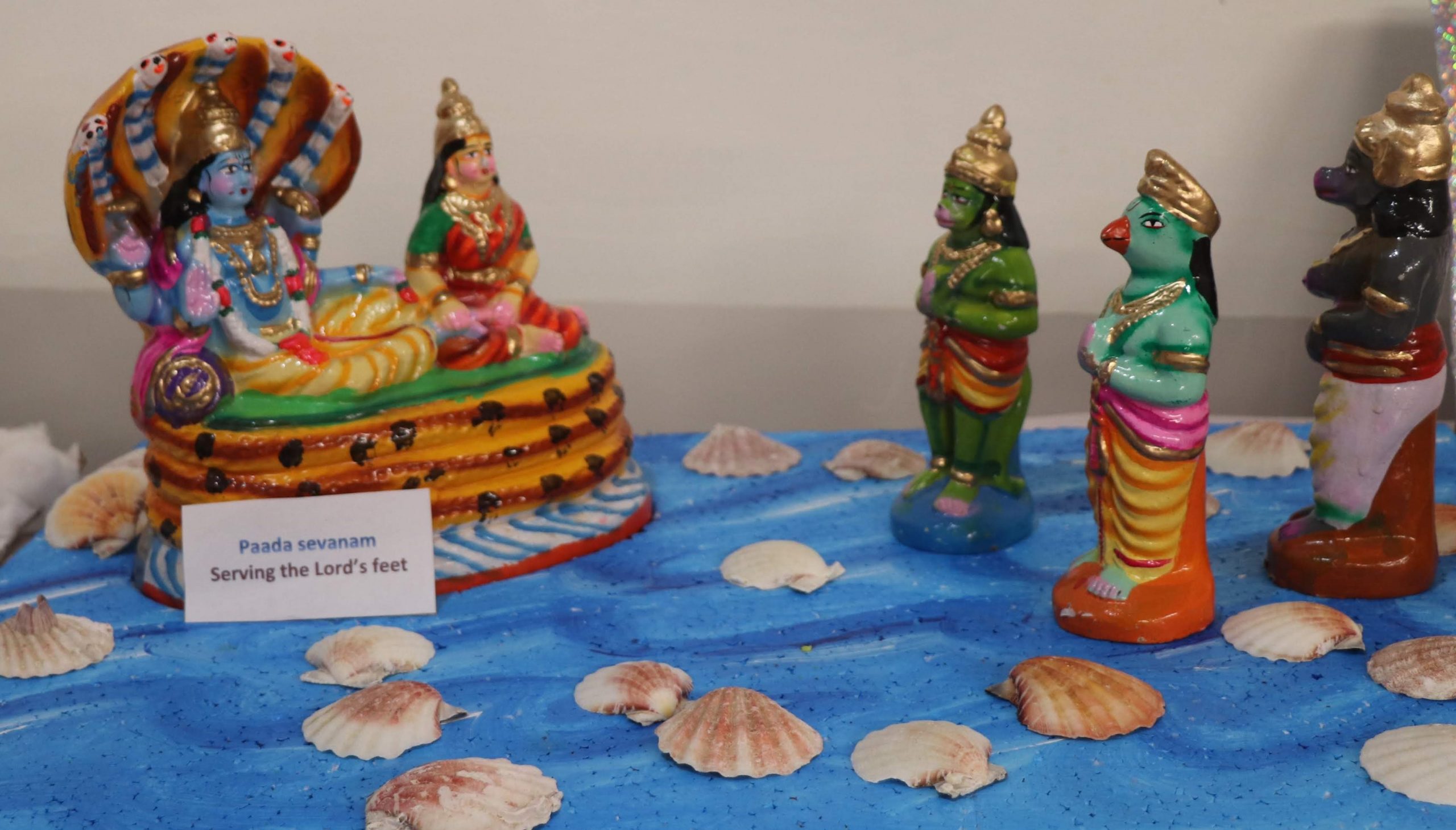
Archanam – Worshiping the Lord
Story of King Ambarisha and Sage Durvasa
King Ambarisha was an ardent devotee of Hindu God Vishnu and performed the Ekadesi fasting without a break. A jealous Indra instigated Durvasa Maharishi against King Ambarisha.
Durvasa arrived at the palace of King Ambarisha when he was about to break his Ekadasi fasting. He was received warmly by the king. Rishi was invited for taking food. The Rishi then went to take bath in the Kalindi River and for his prayers.
Durvasa deliberately took longer time to spoil the Ekadasi fasting of King Ambarisha. Dwadasi Tithi had started and the king had to break the fast before the tithi got over.
Durvasa was nowhere to be seen.
King Ambarisha then fed poor people and animals. He kept his food and that of Durvasa and waited for the Rishi to return.
As Dwadasi Tithi was about to end, the palace priests asked him to take a sip of water and end his fasting. King Ambarisha took a sip of water and ended his fast.
Durvasa suddenly appeared and he was furious that Ambarisha had eaten before serving him. Durvasa accused that Ambarisha did not respect the Atithi Devo Bhava concept.
In anger Durvasa released a demon named Krtya. It moved forward to kill Ambarisha. Suddenly, Sudarshana Chakra appeared and killed the demon.
Sudarshana Chakra then advanced towards Sage Durvasa. Durvasa ran for his life. He went to Indra for help. Indra was helpless. Then the Sage went to Brahma and Shiva who both pleaded helplessness.
Durvasa then finally went to Vishnu who asked the sage to take the help of Ambarisha as only he can rescue him.
Ambarisha saved the sage from death by controlling the Sudarshana Chakra. Ambarisha then narrated the greatness of Ekadasi fasting to Sage Durvasa.
This story narrates how worshiping god through fasting and other forms of prayers helps us reach god.
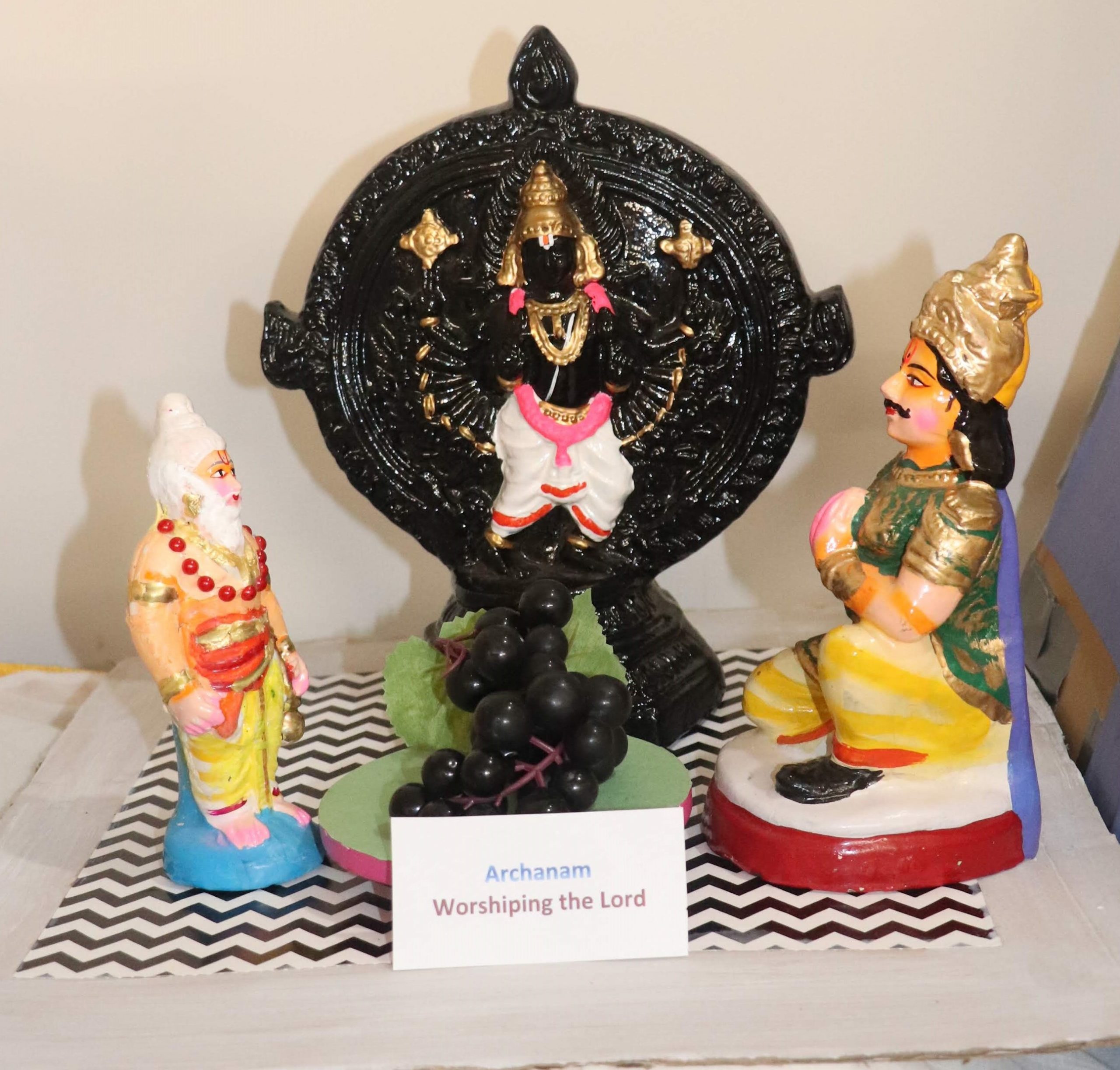
Vandanam – Offering obeisance unto the Lord
Story of Markendeya
The great sage Mrikandu rishi and his wife Marudmati worshipped Shiva and sought from him the boon of begetting a son. As a result, he was given the choice of either a righteous son, but with a short life on earth or a child of low intelligence but with a long life. Mrikandu rishi chose the former, and was blessed with Markandeya, an exemplary son, destined to die at the age of 16.
Markandeya grew up to be a great devotee of Shiva and on the day of his destined death he continued his worship of Shiva in his aniconic form of Shivalingam. The messengers of Yama, the god of death were unable to take away his life because of his great devotion and continual worship of Shiva. Yama then came in person to take away Markandeya’s life, and sprung his noose around the young sage’s neck. By accident or fate the noose mistakenly landed around the Shivalingam, and out of it, Shiva emerged in all his fury attacking Yama for his act of aggression. After defeating Yama in battle to the point of death, Shiva then revived him, under the condition that the devout youth would live forever. For this act, Shiva was thereafter also known as Kalantaka (“Ender of Death”) or Kala Samhara Murthi.
This story details on how offering obeisance to the lord is a wonderful way to reach him.
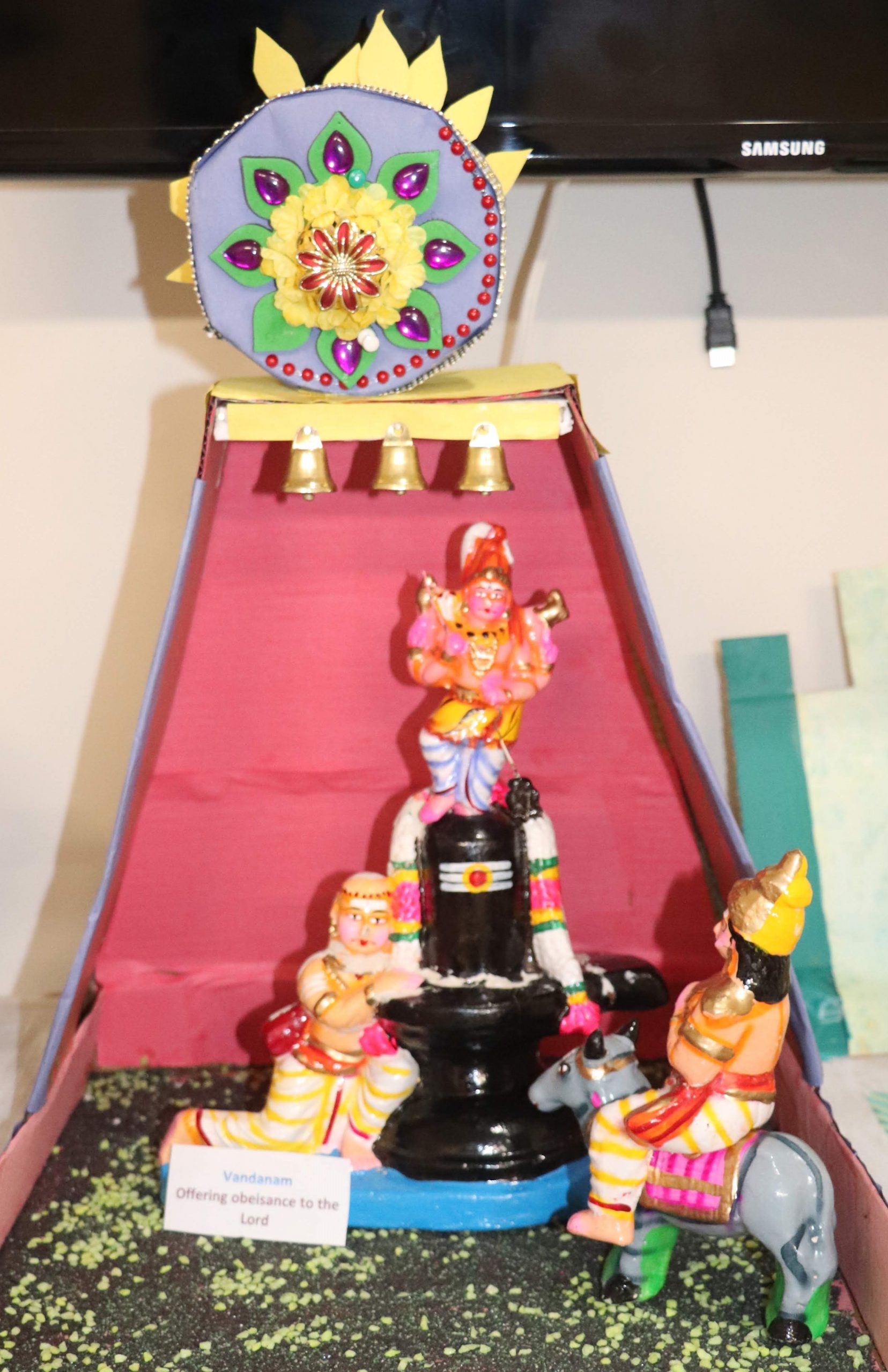
Daasyam – Serving the Lord as His servant
Story of Hanuman
Lord Hanuman is a great devotee of Lord Rama, He is one of the Chiranjeevis who still lives in the world. He is believed to be appear wherever Ram Naam Japam ( Chanting of Lord Ram’s name) happens.
After coming back victorious from the battle, Rama was rewarding everyone who helped him in the battle. When he asked Hanuman what he wanted as a gift, Hanuman refused to take anything. Watching this exchange, Sita gave Hanuman her pearl necklace. Hanuman accepted the gift, and he started breaking each pearl with his teeth. Astonished, Sita asked Hanuman why he was breaking the pearls, and he replied that he was looking for Rama in the pearls, but he can’t find him. The ministers of the court started mocking Hanuman for his devotion, and one of them asked Hanuman if his body also has Rama in it. In response, Hanuman tore his chest apart with his hands and residing in his heart was the image of Rama and Sita. Everyone was shocked by his devotion and congratulated him.
Lord Hanuman is a great example of serving the God as a servant and reaching him through the service.
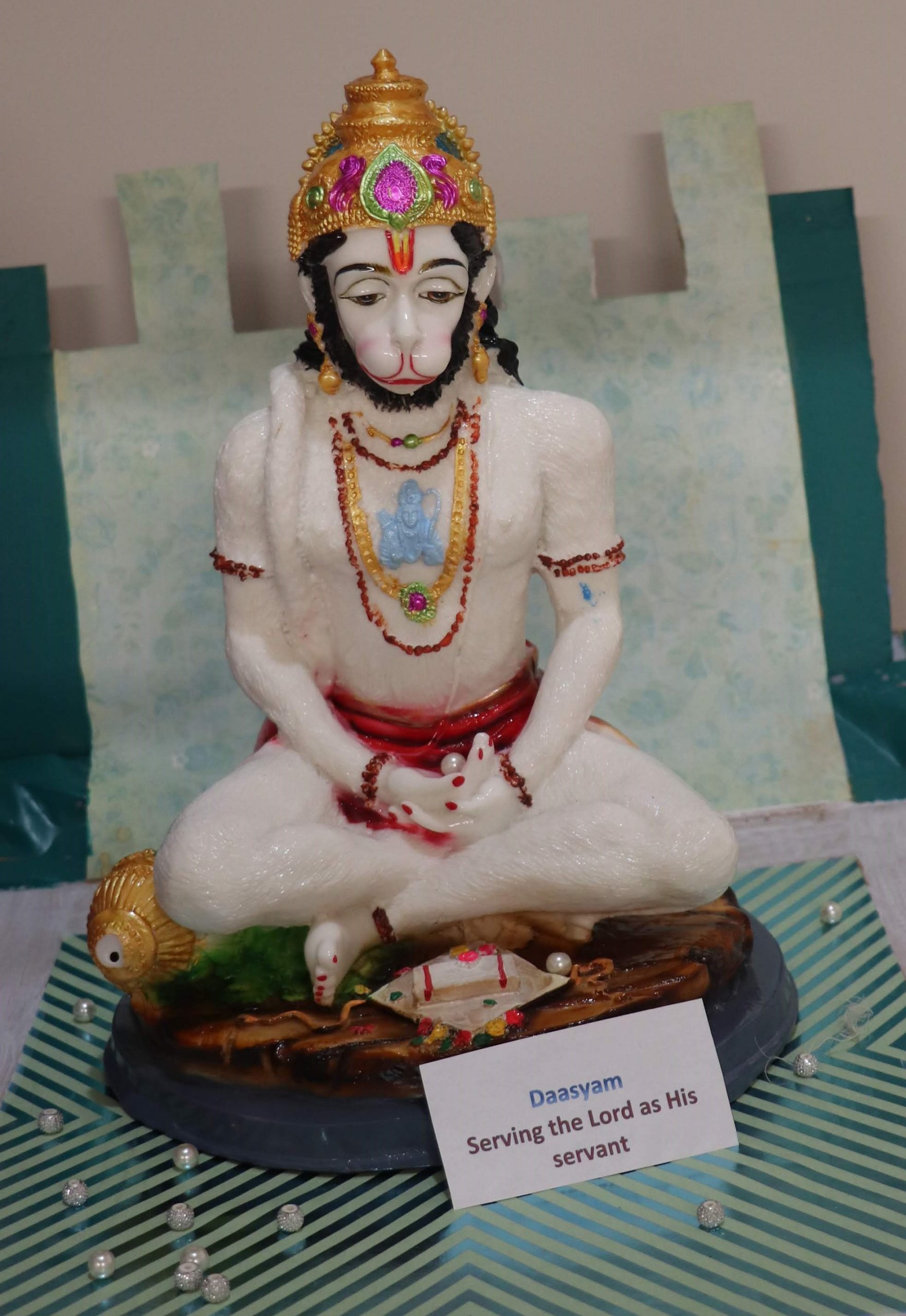
Sakhyam – Developing friendship with the Lord
Story of Krishna and Sudama
Krishna and Sudama where Childhood friends who studied together under Sage Sandipani. While Krishna became a king, Sudama remained a very poor man. And once Sudama’s wife asked Sudama to reach out to Krishna for help . Sudama was reluctant to reach out to Krishna but as there was no other way, he decided to meet Krishna. Since there is a custom that you tkae something with you ,when you go to meet somebody, Sudama took the rice crisps left at home with him for Krishna.
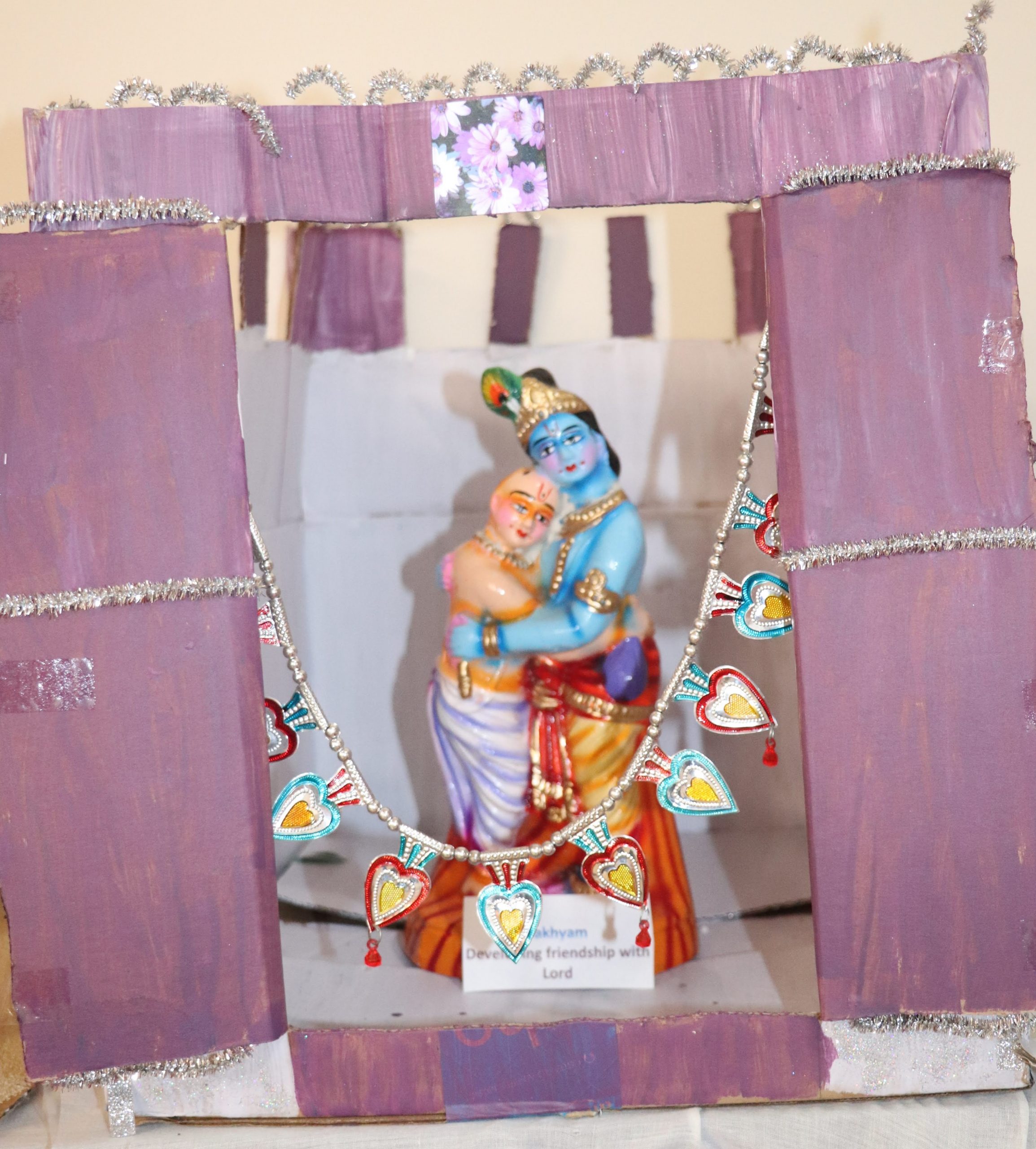
Aatma Nivedanam – Total surrender of oneself to the Lord
Mahabali he was a Asura (Demon) King in the lineage of Prahlada. Prahlada, his grand father was an ardent and coveted devotee of Lord Vishnu for whose sake the Lord took the Narasimha avatar. Sage Sukrachaarya (Guru of the asuras) was his preceptor helping King Bali in all his endeavors.
Bali was a mighty and valorous Asura who had conquered all the three worlds including Heaven and Indra had to surrender to him. At the same time he was virtuous and dedicated to the welfare of the people in his kingdom. He was also famous and known for his charitable qualities. King Bali learned all the Shastras and obtained Vedic knowledge under the guidance and supervision of his illustrious grand father Prahlada. During his reign the country and the people were very prosperous.
Celebrating his successful expedition of conquering the three worlds . Mahabali was performing a great Yagna with the help of his Guru, Sage Sukrachaarya.
Lord Vishnu in his Vamana avatar entered as a Brahmachari where, Bali was performing Aswamedha yaga and asked Mahabali for three paces of land measured by his foot as charity. When King Bali was in the process of fulfilling the request of Vamana, Sage Sukracharya realizes that Vamana was none other than the Supreme Lord Vishnu himself. Sensing the trickery of Lord Vishnu, Sukracharya advises and prevails upon King Bali to retract from his promise.
But Bali refused to heed to his Guru’s words and insists upon going ahead with his promise to the Lord Vamana. King Bali is a classic example of Aatmanivedanam, complete surrender with devotion to the Supreme Lord and taking refuge in Him to achieve the ultimate goal.
Knowing fully well that he is going to lose his rulership on the three worlds and that is going to ruin him. Bali did not deter from the curse given by his preceptor since the offering is to the Supreme Lord who is the Supreme Preceptor.
Ultimately when King Bali fell short of fulfilling his promise given to Vamana, he surrendered completely before the Supreme Lord for which he was amply rewarded by the Lord for his virtues. He became the ruler of Suthala (Nether world) with Lord himself protecting his kingdom, became immortal, and got identified as the future Indra of the next Manvanthara period.
